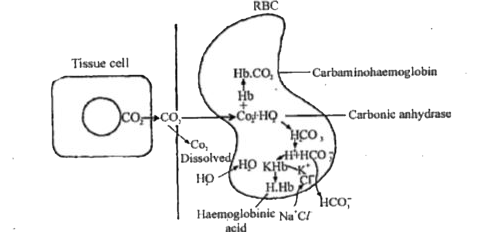Explain the transport of CO2 by blood from tissue to lungs.
Transport of carbon dioxide: CO2 is produced in tissues by cell respiration. It is carried by blood in three forms:
i) Dissolved CO2 or Physical solution: About 7% of carbon dioxide dissolves in plasma and is carried as a physical solution.
ii) Bicarbonate ions : Maximum amount of carbondioxide diffuses from the plasma into red blood corpuscles. About 70% of CO2 enters the RBCs. It combines with water to form carbonic acid. The reaction is catalysed by carbonic anhydrase.
Co2+H2Ocarbonic⇐===⇒anhydraseH2CO3
H2CO3⇔H++HCO−3
Carbonic acid dissociates into bicarbonate and hydrogen ion. Hydrogen ion is picked up by proteins and bicarbonate ions are joined by bases to maintain pH of the blood. A small amount of bicarbonate ions is transported in RBC, while most of them diffuse into plasma. The exit of bicarbonate ions changes ionic balance between plasma and erythrocytes. To restore the ionic balance, the chloride ions diffuse from the plasma into erythrocytes. This movement of chloride ions is known as chloride shift or Hamburger.s phenomenon.
iii) Carbaminohaemoglobin: About 23% of carbondioxide enters RBCs. It combines with amino groups of globin part of haemoglobin. This type of combination also occurs with other proteins present in the plasma.
RNH2+CO2⇔RNHCOOH
Amino group⇔Carbamino compound
Hb+CO2⇔HbCO2 (Carbaminohaemoglobin)
Formation of carbamino bond in haemoglobin does not reduce its oxygen carrying capacity because O2 combines with haeme group while CO2 attaches to amino group of globin. About 3.7 cc of CO2 passes into 100 cc of blood in tissues. The same amount is released in lungs. It combines with HCO−3 ions to form carbonic acid. Carbonic acid dissociates to form CO2 and H2O .

Similar Questions
How is CO2 transported fom tissues to lungs?
View SolutionExplain the transport of O2 and CO2 between alveoli tissue with diagram.
View SolutionWhich of the following is correct about the transport of carbon dioxide from the tissue to lung alveoli ?
View SolutionWhich of the following is correct about the transport of carbon dioxide from the tissue to lung alveoli ?
View SolutionName three forms by which CO2 is transported by blood from body tissues to the lungs .
View SolutionExplain the transport of O2 and CO2 between alveoli and tissue with diagram.
View SolutionExplain the transport of O2 and CO2 between alveoli and tissue with diagram.
View SolutionThe enzyme essential for the transport of CO2 as bicarbonate in blood is
View SolutionHow does haemoglobin help in the transport of oxygen from lung to tissue?
View SolutionA portion of cardiovascular system that transport oxygen depleted blood from the heart to the lungs and brings oxygenated blood back to heart is
View Solution

